
The Bristol Pegasus is a British nine-cylinder, single-row, air-cooled radial aero engine. Designed by Roy Fedden of the Bristol Aeroplane Company, it was used to power both civil and military aircraft of the 1930s and 1940s. Developed from the earlier Mercury and Jupiter engines, later variants could produce 1,000 horsepower (750 kW) from its capacity of 1,750 cubic inches by use of a geared supercharger.
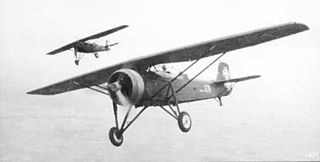
The ANBO IV was a reconnaissance aircraft used by the Lithuanian Air Force in World War II, designed by Lithuanian aircraft designer Antanas Gustaitis. The Lithuanian ANBO 41 was far ahead of the most modern foreign reconnaissance aircraft of that time in structural features, and most importantly in speed and in rise time. All ANBO 41 aircraft were likely destroyed during World War II.

The Lithuanian Air Force or LAF is the military aviation branch of the Lithuanian armed forces. It is formed from professional military servicemen and non-military personnel. Units are located at Zokniai Air Base near the city Šiauliai, at Radviliškis and Kaunas.
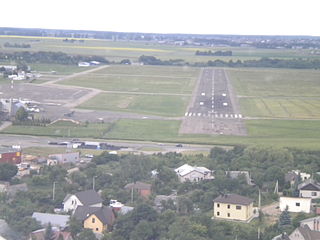
S. Darius and S. Girėnas Airport, also known as Aleksotas Airport, is a small airport located in Aleksotas district of Kaunas City (Lithuania), about 3 kilometres South-west from city centre. On May 6, 1993, the airport was named after the Lithuanian pilots Steponas Darius and Stasys Girėnas, who perished in a crash near the end of an attempted non-stop flight from New York to Lithuania in 1933.

The ANBO I was a single-seat aircraft developed in Lithuania, proposed as a trainer for the Army It was a low-wing, braced monoplane of conventional tailwheel configuration. The fuselage structure was of fabric-covered welded steel tube, The wing had a wooden, two-spar structure and was fabric covered but the fuselage, also fabric covered, had a welded steel tube structure.
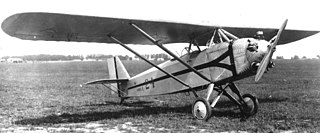
The ANBO II was a parasol-wing monoplane aircraft built in Lithuania in 1927 as a pilot trainer for the Army. It was the first Lithuanian trainer aircraft of own design. It was eventually reequipped with more powerful engine for the Aero Club of Lithuania in 1931 before being written off after a crash in 1934.
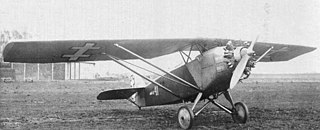
The ANBO III was a parasol-wing monoplane training and utility aircraft designed for the Lithuanian Army in 1929. It became the first aircraft of Lithuanian design to be built in series, with two batches of four aircraft produced in 1930 and 1931. The ANBO IIIs also saw service as reconnaissance machines.
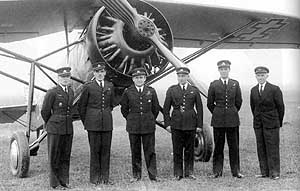
The ANBO V was a parasol wing monoplane training aircraft designed for the Lithuanian Army in 1931. A developed version, the ANBO 51 followed in 1936 and 1938.

The Walter NZ 60 was a five-cylinder, air-cooled, radial engine for aircraft use built in Czechoslovakia by Walter Aircraft Engines in the 1920s.

The Walter Venus was a seven-cylinder, air-cooled, radial engine for aircraft use, built in Czechoslovakia in the late 1920s.

The Walter Vega was a five-cylinder, air-cooled, radial engine for aircraft use, built in Czechoslovakia in the late 1920s.

The Armstrong Siddeley Genet Major is a British five-cylinder, air-cooled, radial engine for aircraft, designed and built by Armstrong Siddeley and first run in 1928. It developed 140 horsepower (104 kW). In Royal Air Force use the seven-cylinder version was known as the Civet I. The Feliform names used are in line with company convention, the Genet and Civet both being large cat-like carnivores.

The Curtiss R-600 Challenger was a six-cylinder, double-row, air-cooled, radial engine for aircraft use built in the United States in the late 1920s. It developed 170 to 180 horsepower.

Yakushima is a town located in Kumage District, Kagoshima, Japan. The town is on the island of Yakushima and Kuchinoerabujima.

The ANBO VIII was a Lithuanian bomber-reconnaissance monoplane designed by Antanas Gustaitis and built by Karo Aviacijos Tiekimo Skyrius.
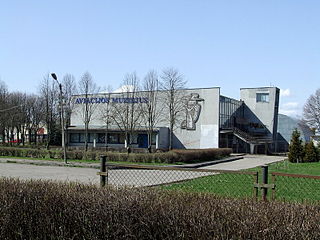
The Lithuanian Aviation Museum is located in Kaunas, Lithuania. The museum was officially opened in 1983. The permanent collection of the museum contains more than 18 000 displays of different fields of technology. The major part of the collection is dedicated to the history of aviation in Lithuania. It includes about 40 flying machines, models of airplanes, flyers, gliders and helicopters of various times, and designed during the Interwar period of Lithuania first combat aircraft the ANBO I by General Antanas Gustaitis.

The Walter Mars I was a nine-cylinder, air-cooled, radial engine for aircraft use built in Czechoslovakia in the late 1920s.

Natalia Liane den Haan is a Dutch politician and former nonprofit director, who has been a member of the House of Representatives since 2021.


















